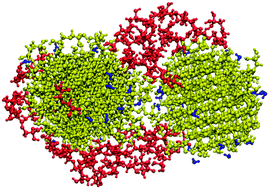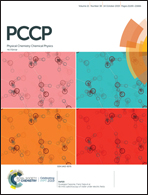A ReaxFF molecular dynamics study of molecular-level interactions during binder jetting 3D-printing†
Abstract
In the present work, we study one of the major additive manufacturing processes, i.e., the binder jetting printing (BJP) process, at the molecular level through atomistic-scale level representations of powders and binder solutions with chromium-oxide (Cr-oxide) nanoparticles and water-based diethylene glycol solutions, respectively. The results show that both diethylene glycol and water contribute to the bonding of Cr-oxide particles during the print and curing stages by forming a hydrogen bond network. Heating the system to the burn-out temperature results in the oxidation of diethylene glycol and the decomposition of the hydrogen bond network. Subsequently, Cr-oxide particles are partially sintered by forming Cr–O bonds. The final sintering facilitates further Cr–O bond formation. Additionally, the influence of the chemical composition of the binder solution is investigated by performing ReaxFF molecular dynamics simulations on two sets of systems, which control the number of water and diethylene glycol molecules, respectively. Our results demonstrate that adding both diethylene glycol and water to the binder solution can raise the number of “useful” hydrogen bonds, resulting in a higher breaking strength at the print and curing stages. During the burn-out and sintering stages, the influence of water on the breaking strength is not obvious. In contrast, an optimal quantity of binder species exists for the breaking strength after sintering. A comparison of the ReaxFF molecular dynamics simulations using 2-ethoxyethanol, diethylene glycol and 1-(2,2,2-trihydroxyethoxy)ethane-2,2,2-triol as the binder phase indicates that an increasing number of hydroxyl groups leads to higher breaking strength at the print and curing stages. The findings from this study can be extended to identify the optimal binder chemistry, curing and sintering conditions for different material systems.



 Please wait while we load your content...
Please wait while we load your content...